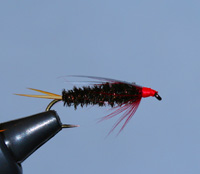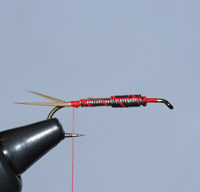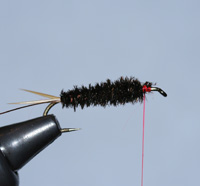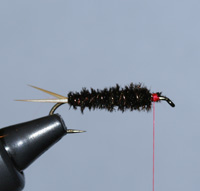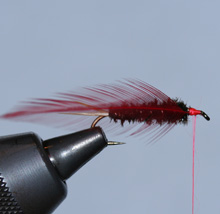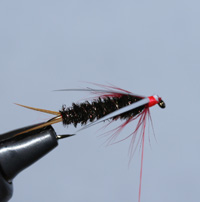The Prince Nymph has been one of our favorite flies for a long time. We’ve caught lots of big trout with it not only in the Smokies but in Western rivers as well. We fish it frequently from the first cold snaps of fall through the winter and spring. We’ll continue to fish it in the summer if water levels are a little high. The Prince is one of those flies that always seems to catch fish when we fish it in swift water. We like to fish it on the heavy side so it gets down deep quickly. The instructions shown here show our favorite variation with red hackle and red thread, but you can use the standard brown hackle with black thread and it will still work great. Our suggestions for fishing the Prince Nymph are at the end of the tying instructions.
Hook: #8 – #12 Extra Long Shank Nymph or Standard Streamer Hook
Underbody: .010 – .015 Round Lead Free Wire
Thread: 6/0 Fire Orange, Red, or Black
Tail: Ginger Goose Biots
Rib: Copper Wire
Body: Peacock Herl
Hackle: Red or Brown Chinese Hackle or other soft hackle for wet flies and nymphs
Wings: White Goose Biots
Step 1.
Starting near the rear of the hook shank wrap lead free wire forward to about one and a half hook eye lengths behind the eye of the hook. Wrap 1/2 to 2/3 of the way back over the first layer of wire. This makes the fly heavy so it sinks quickly and also helps to give the body a natural looking taper.
Step 2.
Start to wrap thread just behind the eye of the hook and continue over the wire underbody. Wrap to the bend of the hook. Tie in two ginger goose biots so the natural bend of the feather points outward and away from each other.
Step 3.
Tie the copper wire just ahead of the goose biots, then tie in about 5 or 6 strands of peacock herl. Be sure the strands of herl are close to even along the tips, then clip about 1/2″ from the tips since they are weak and often break. Tie the peacock in at the tips then wrap the thread over the wire underbody up to the bare hook near the head.
Step 4.
Wrap the strands of peacock herl forward over the wire under body. Tie off with the thread and clip off any excess. Be sure to leave some space. Don’t crowd the eye of the hook.
Step 5.
Wrap the copper wire forward using a reverse wrap. That is wrap the wire forward in the opposite direction that you wound the peacock herl. This keeps the wire from becoming buried in the herl. More importantly it allows the wire to wrap over the top of the fragile peacock and adds durability to the fly.
Step 6.
Prepare a piece of hackle by clipping the base away and stripping some hackle fibers from the stem so it will tie in cleanly. Tie the feather in so the shiny side is forward and the natural bend of the feather is toward the rear of the fly.
Step 7.
Wrap the feather around the hook 2 or 3 times and tie it off. Clip the tip of the feather off. Now using the thumb and forefinger of your free hand pull the hackle fibers back. Wrap thread over the base of the hackle fibers so they lay back.
Step 8.
Tie in two white goose biots so the natural curve of the feather is downward. Tie each one in at a slight angle off to each side and try to make them symmetrical. Clip the base of each biot after it is tied in.
Step 9.
Wrap thread over what remains of where you clipped the white biots. Wrap to the eye of the hook and finish the fly with a few half hitches or a whip finish.
Fishing Suggestions
The Prince Nymph is an excellent choice for cold water conditions in the fall, winter, or spring. Its contrasting colors allow fish to see it in swift flows and its weight gets it in the strike zone quickly. Don’t be afraid to add a split shot or two if you don’ t think it’s reaching bottom. Fish it no less than 24″ under a strike indicator, but don’t be afraid to put it 36″ or 48″ deep
The Prince is a superb fly to use with another nymph. There are many times in the spring when smaller mayflies are moving about to hatch. We’ll fish a #12-16 Beadhead Pheasant Tail Nymph about 18″ – 24″ up from the Prince. This allows us to fish two entirely different flies in two different locations. The Prince should be ticking bottom and the smaller Pheasant Tail is higher in the water column like a hatching or drifting mayfly nymph.
Don’t try to fish this large Prince Nymph with fine tippet like 6X. This fly is intended for hard work and will hopefully hook nice trout from pockets in swift water. We usually use 3X or 4X when fishing it. That also goes for when we use a smaller nymph in tandem. Swift, turbulent water conditions preclude any need for a fine tippet plus you’ll be grateful that you have it when you hook a strong fish in a rocky run of fast water.
